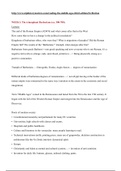Class notes
Class notes Medieval History - A Short History of the Middle Ages
- Course
- Institution
- Book
A complete summary of all the lectures (week 1 to 7) of the course of Medieval History combined with a short schematic overview of the main points for every chapter (1-8) of the book "A Short History of the Middle Ages" by Barbara Rosenwein. My exam grade: 7.5
[Show more]




